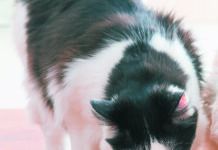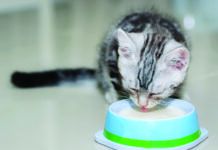[From Tufts June 2012 Issue]
If you compare the “Guaranteed Analysis” on a can of wet cat food to the one on a bag of dry kibble, the dry food would seem the obvious choice because it shows much higher percentages of protein, fat, and fiber. But that’s only because canned food, which contains more water, is more dilute. The nutrients the cat actually ingests in a serving are more dependent on the product than the form in which it’s delivered. “There is no inherent reason to feed canned or dry food other than pet or owner preference,” says Lisa Freeman, DVM, PhD, a veterinary nutritionist at Tufts Cummings School of Veterinary Medicine. What is important is to select a good-quality food manufactured by a well-known, reputable company.
Granted, for cats with lower urinary tract problems, including bladder stones or cystitis, wet food makes a better choice because of its higher moisture content. In such cases, it’s important to keep the urine dilute, and “it has been shown that cats who eat wet food take in more water than those who eat dry food,” explains small animal kidney specialist Linda Ross, DVM. Cats who eat dry food don’t drink enough extra water to quite make up the difference.
On the flip side, dry food is a little better for dental hygiene than wet, but much more important to the health of a cat’s teeth are that you brush them regularly and take the cat for periodic teeth cleanings at the veterinarian’s office.
As for the rumor that dry food causes feline diabetes, it is just that — a rumor. Dry food, some of which is calorie dense,
can be particularly palatable (especially if it’s grain-free and low in carbohydrates), and some cat owners leave out more than a serving at a time in the mistaken belief that all cats can self-regulate the amount of food they eat without any portion control. But that’s not true, and the obesity that can ensue when cats are left to eat dry food ad libitum can contribute to the development of diabetes. It’s not something about the dry food itself.
It’s also a rumor that the preservatives in dry kibble are bad for cats. No proof of harm from preservatives used in cat food has ever been scientifically documented, whether the preservatives are natural (such as vitamin C) or artificial (like BHA or ethoxyquin, which manufacturers are moving away from not because of safety issues but because of market demand). To the contrary, there would be much harm without preservatives. Food spoilage resulting from faster rancidity could make a cat sick. (Food spoilage resulting from leaving out wet food too long could make a cat sick, too. The airtight storage that results from canning protects canned cat food, but once the food is opened and put in a bowl for the cat, it should be left out no more than a couple of hours.)
For all these reasons, at the end of the day, the choice of whether to buy your cat wet or dry food should generally not be driven by concerns about health.



This article is very useful for all the cat lovers.